Gibraltar
- mpluhar9
- Jul 10, 2013
- 20 min read
Gibraltar is a British Overseas Territory located on the southern end of the Iberian Peninsula at the entrance of the Mediterranean. It has an area of 2.3 square miles and a northern border with theProvince of Cádiz in Andalusia, Spain. The Rock of Gibraltar is the major landmark of the region. At its foot is a densely populated city area, home to almost 30,000 Gibraltarians and other nationalities.
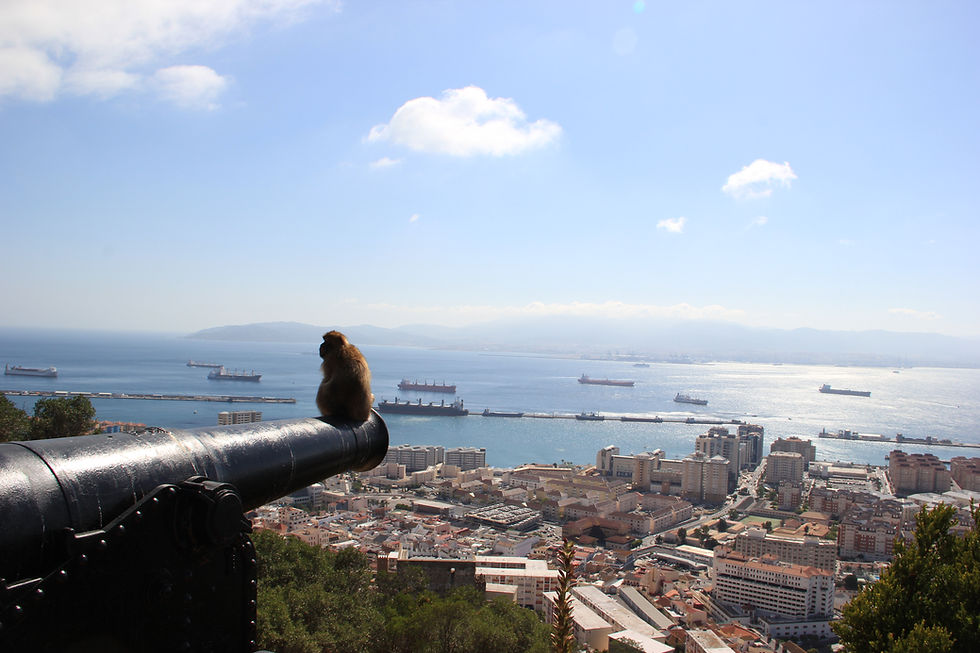

An Anglo-Dutch force captured Gibraltar from Spain in 1704 during the War of the Spanish Succession on behalf of the Habsburg pretender to the Spanish throne. The territory was subsequently ceded to Britain "in perpetuity" under the Treaty of Utrecht in 1713. It was an important base for the Royal Navy; today its economy is based largely on tourism, online gambling, financial services, and shipping.

The sovereignty of Gibraltar is a major point of contention in Anglo-Spanish relations as Spain asserts a claim to the territory. Gibraltarians overwhelmingly rejected proposals for Spanish sovereignty in a 1967 referendumand again in 2002. Under the Gibraltar constitution of 2006, Gibraltar governs its own affairs, though some powers, such as defence and foreign relations, remain the responsibility of the UK Government.
Gibraltar Cable Car
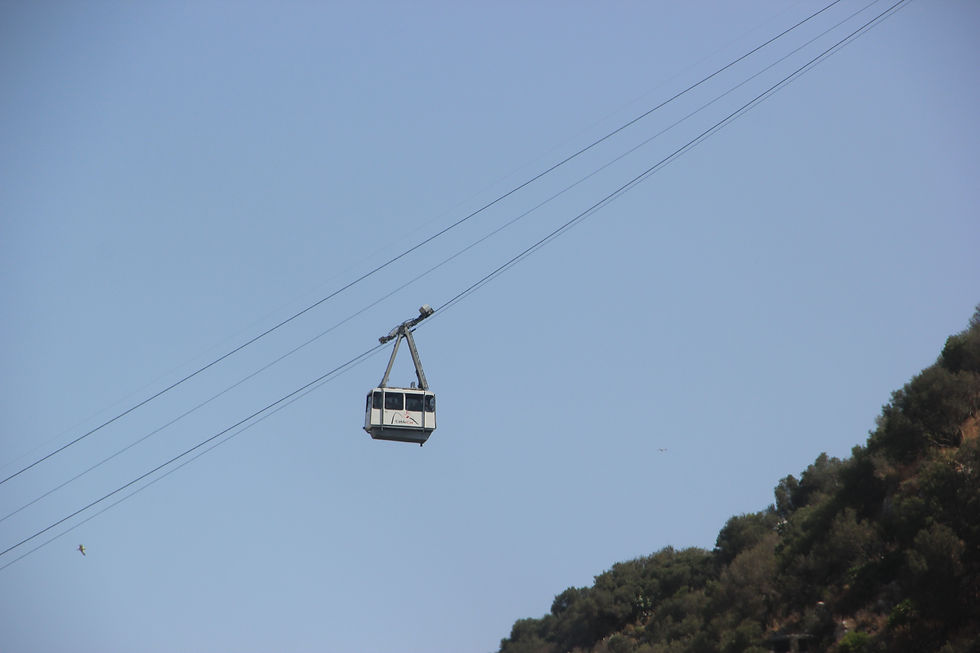
Gibraltar Cable Car is an aerial tramway in Gibraltar. The base station of the cable car is located near the southern end of Main Street, next to Alameda Gardens.
The Gibraltar Cable Car was built in 1966 by Swiss cable car experts Von Roll Holding, atop Signal Hill Battery. The battery was located alongside a Signal Station and was equipped with two 3-inch 30-cwt anti-aircraft guns and a 40-mm Bofors gun during World War II. Remains of an earlier cable station that was used to bring supplies (or a brave man) up to the top of signal hill via a rope are still evident. Besides the remains of earlier military buildings there is also a short tunnel that runs east to west under the station. The last extensive renovation of the cable car took place in 1986 when the cable cars were replaced with the current day cabins. In 2007 the Top Station was refurbished and replaced with the current facilities including the Calpe Suite which is registered to conduct weddings.
rom the base station, the cable car travels up the Rock of Gibraltar to the Ape's Den midway up the Rock, and then to the top of the Rock. Despite being called "top of the Rock", it is actually the second highest peak of the Rock at 412 metres (1,352 ft) above sea level. There are 673 metres between the two stations and the cars can take an attendant and 30 people up or down the cables. The cars travel between the three towers and the journey takes approximately six minutes at a speed of 5 metres per second. During the journey, audio tour guides describe historical background on the sights of Gibraltar. At the top is a restaurant, café, toilet facilities, and terraces which offer views across the Strait of Gibraltar to Morocco, the Bay of Gibraltar towards Algeciras, and up the east coast towards Marbella. Bus number 2, 3 and 4 stop close by to the base station. Parking is available in Grand Parade next to the base station.
Gibraltar Rock
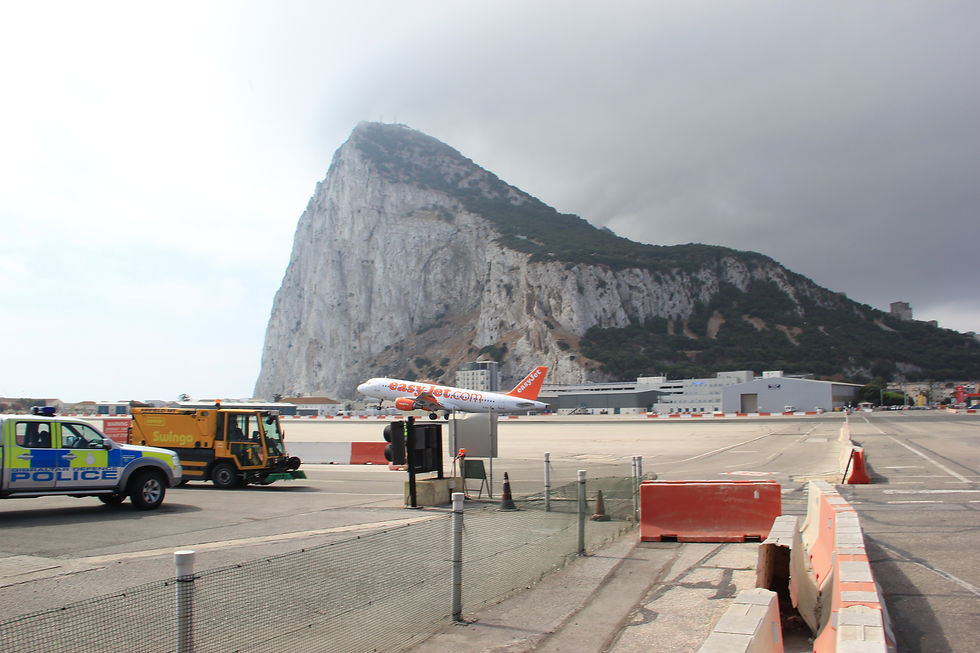
The Rock of Gibraltar is a monolithic limestone promontory located in the British overseas territory of Gibraltar, off the southwestern tip of Europe on the Iberian Peninsula. It is 426 m high. The Rock is Crown property of the United Kingdom, and borders Spain. Most of the Rock's upper area is covered by a nature reserve, which is home to around 300 Barbary macaques. These macaques, as well as a labyrinthine network of tunnels, attract a large number of tourists each year. The Rock of Gibraltar was one of the Pillars of Hercules and was known to the Romans as Mons Calpe, the other pillar being Mons Abyla or Jebel Musa on the African side of the Strait. In ancient times the two points marked the limit to the known world, a myth originally fostered by the Greeks and the Phoenicians
The Rock of Gibraltar is a monolithic promontory. It is a deeply eroded and highly faulted limb of an overturned fold. The sedimentary strata comprising the Rock of Gibraltar are overturned (upside down) with the oldest strata overlying the youngest strata. These strata are the Catalan Bay Shale Formation (youngest), Gibraltar Limestone, Little Bay Shale Formation (oldest), and Dockyard Shale Formation (age unknown). These strata are noticeably faulted and deformed.
Predominately of shale, the Catalan Bay Shale Formation also contains thick units composed of either brown calcareous sandstone, soft shaly sandstone interbedded with bluish-black limestone, and interlayered greenish-gray marls and dark gray cherts. The Catalan Bay Shale Formation contains unidentifiable echinoid spines and belemnite fragments and infrequent Early Jurassic (Middle Lias) ammonites. The Gibraltar Limestone consists of greyish-white or pale-gray compact, and sometime finely crystalline, medium to thick bedded limestones and dolomites that locally contain chert seams. This formation comprises about three quarters of the Rock of Gibraltar. Geologists have found various poorly preserved and badly eroded and rolled marine fossilswithin it. The fossils found in the Gibraltar Limestone include various brachiopods, corals, echinoid fragments, gastropods, pelecypods, and stromatolites. These fossils indicate an Early Jurassic age (Lower Lias) for the deposition of the Gibraltar Limestone. The Little Bay and Dockyard shale formations form a very minor part of the Rock of Gibraltar. The Little Bay Shale Formation consists of dark bluish-gray, unfossiliferous shale, which is interbedded with thin layers of grit, mudstone, and limestone. It predates the Gibraltar Limestone. The Dockyard Shale Formation is an undescribed variegated shale of unknown age that lies buried beneath the Gibraltar's dockyard and coastal protection structures. Although these geological formations were deposited during the early part of the Jurassic Period some 175-200 million years ago, their current appearance is due to far more recent events of about 5 million years ago. When the African tectonic plate collided tightly with the Eurasian plate, the Mediterranean became a lake that, over the course of time, dried up during the Messinian salinity crisis. The Atlantic Ocean then broke through the Strait of Gibraltar, and the resultant flooding created the Mediterranean Sea. The Rock forms part of the Betic Cordillera, a mountain range that dominates south-eastern Iberia. Today, the Rock of Gibraltar forms a peninsula jutting out into the Strait of Gibraltar from the southern coast of Spain. The promontory is linked to the continent by means of a sandy tombolo with a maximum elevation of 3 m (9.8 ft). To the north, the Rock rises vertically from sea level up to 411.5 m (1,350 ft) at Rock Gun Battery. The Rock's highest point stands 426 m (1,398 ft) above the strait at O'Hara's Battery. The Rock's central peak, Signal Hill, stands at an elevation of 387 m The near-cliffs along the eastern side of the Rock drop down to a series of wind-blown sand slopes that date to the glaciations when sea levels were lower than today, and a sandy plain extended east from the base of the Rock. The western face, where the City of Gibraltar is located, is comparatively less steep. Calcite, the mineral that makes up limestone, dissolves slowly in rainwater. Over time, this process can form caves. For this reason the Rock of Gibraltar contains over 100 caves. St. Michael's Cave, located halfway up the western slope of the Rock, is the most prominent and is a popular tourist attraction. Gorham's Cave is located near sea level on the steep eastern face of the Rock. It is noteworthy because archaeological excavations in the cave have found evidence that Neanderthals used it as far back as 30,000 years ago. It is especially significant because plant and animal remains found in the cave (and others nearby) indicate that the Neanderthals had a highly varied diet.
Moorish Castle
The Moorish Castle is the name given to a Medieval fortification in Gibraltar, made up of various buildings, gates, fortified walls and its most dominant features, the Tower of Homage and the Gate House. Part of the castle itself also housed HM Prison of Gibraltar until it was relocated in 2010. The former is clearly visible to all visitors to Gibraltar, not only because of its striking construction but also because of its dominant and strategic position. Although sometimes compared to nearby alcazars in Spain, the Moorish Castle in Gibraltar was constructed by the Marinid dynasty, making it unique in the Iberian Peninsula. Gibraltar has always been of special significance to the numerous peoples and civilizations that have visited or occupied it over the ages, from the Neanderthal period, through the Classical and on to the Moorish, Spanish and the present British rule. The Moorish occupation is by far the longest in Gibraltar's recorded history, having lasted from 711 to 1309 and then again from 1350 to 1462—a total of 710 years.
The importance of Gibraltar to both Muslims and Christians lies in the fact that the Moorish invasion and occupation of Europe started from Gibraltar in 711 and, through to its final recapture by Spain in 1462, Moorish rule was gradually undermined until, with the fall of Granada in 1492, the Moorish conquest of Europe came to an end after 781 years. The Moorish conquest of Spain was led by Tarik ibn Ziyad and Musa ibn Nusayr. Gibraltar thus became the stepping-stone to the conquest of Spain and part of France. This spectacular feat of arms took a mere twenty-two years, no mean task considering the distances involved, the state of the terrain at the time and the fact that mechanical power had not yet been invented.[4] The strategic importance of Gibraltar rose in the last years of the Moorish rule, since it became, after the successful conquest by the Christians of all the Guadalquivir valley, one of the key elements in the communication between the Kingdom of Granada and the Moorish domains in the North of Africa. The construction of the Moorish Castle was commenced in the 8th century AD (possibly AD 711), but there is no record of when it was completed. Its walls enclosed a considerable area reaching down from the upper part of the Rock of Gibraltar down to the sea. The most conspicuous parts of the Castle now remaining are the upper tower, or Tower of Homage, together with various terraces and battlements below it, and the massive Gate House, with its cupola roof.
Europa Point
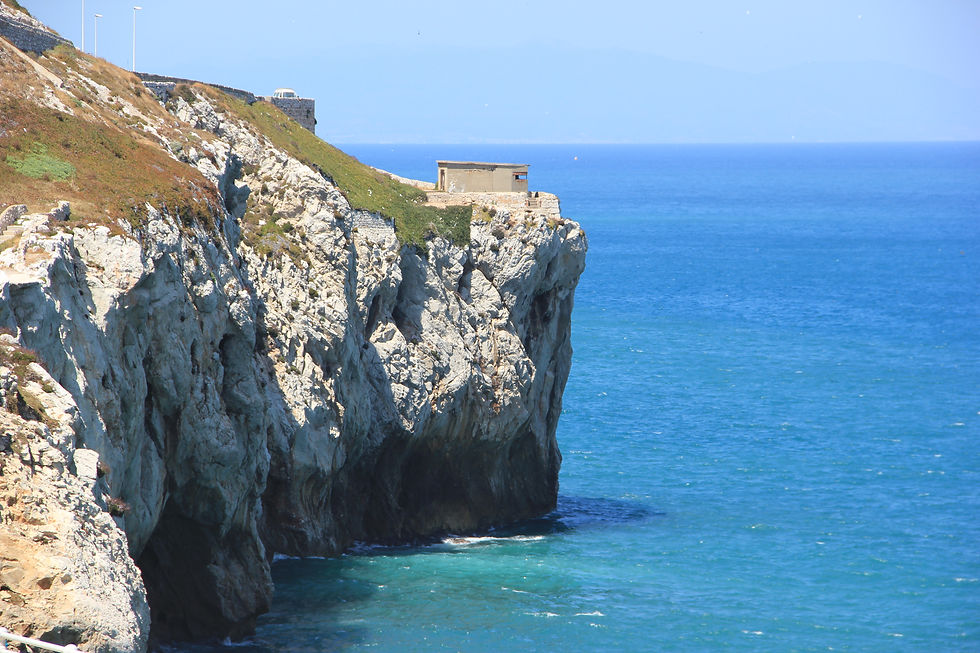

Europa Point is the southernmost point of Gibraltar. At the end of the Rock of Gibraltar, the area is flat and occupied by such features as a playing field and a few buildings. On a clear day, views of North Africa can be seen across the Strait of Gibraltar including Ceuta and the Rif Mountains of Morocco; as well as the Bay of Gibraltar and the Spanish towns along its shores. It is accessed from the old town by Europa Road.
There are five notable buildings, Harding's Battery, the Ibrahim-al-Ibrahim Mosque, the Roman Catholic Shrine of Our Lady of Europe, the Europa Point Lighthouse and the Nun's Well. Europa Point is also the location of Gibraltar's only dedicated cricket oval where the Gibraltar national cricket team play and since 2013 Europa Point has been the location of the Sikorski Memorial.
Europa Point is linked with the Eastern side of the Rock, including Sandy Bay and Catalan Bay, via Dudley Ward Tunnel. The tunnel re-opened in 2010 after eight years closure following a fatal rockfall. The Government of Gibraltar spent £4.4 million on refurbishing Europa Point in 2011 and it was opened by the then Chief Minister of Gibraltar Peter Caruana. In 2013 an original RML 12.5 inch 38 ton gun was mounted on a custom made replica carriage at Hardings's Battery and the memorial to General Wladislaw Sikorski was relocated here from Sir Herbert Miles Road.
Harding's Battery

Harding's Battery is a restored artillery battery in the British Overseas Territory of Gibraltar. It is located at Europa Point and includes the Europa Sunken Magazine that is now used as a visitor centre.
This battery is on Europa Point at the southern end of Gibraltar. Europa had been the site of earlier Spanish and Moorish fortifications as well as those constructed by the British which included walls, scarping and the batteries. Europa Advance Batteries, Europa Pass Batteries, Europa Batteries, Eliott's Battery, Europa Advance Battery, Half Way Battery, Lighthouse Battery, Lady Louisa's Battery and Woodford's Battery were supported by a local barracks. Harding's battery was built on the remains of the 7th Europa Battery in 1859. The battery was named after Sir George Harding, who was Chief Engineer in 1844 and had been involved with Sir Charles Holloway in the 1810 destruction of the Spanish fortifications including Fort St. Felipe and Fort St. Barbara. At that time Europa Point was known as Harding's Point. For a few years the battery had two 18 pounder guns but these were replaced in 1863 with two 32 pounders. Five years later Harding's was given a Rifled Muzzle Loading gun as part of the recommendations put forward by Colonel William Jervois who was inspecting and advised on the defences of British colonies includingGibraltar and the Andaman Islands from 1865. Jervois's 1868 recommendations took time and the approval was not given until 1876 by which time the 9 inch gun had become a larger 12.5 inch 38 ton RML gun which could fire 800 pound projectiles. This gun was commissioned in 1878 although it was feared that the gun may be difficult to defend in its exposed position. In 1904, a plan was put forward to move a 9.2-inch Mk 1 coastal defence gun from Inchkeith in Scotland to Harding's Battery, but it was never implemented. The large RML was eventually removed and from the start of World War II this battery was the location of a Bofors 40 mm anti-aircraft gun.
Europa Point Lighthouse

The Europa Point Lighthouse, also referred to as the Trinity Lighthouse at Europa Point and the Victoria Tower or La Farola in Llanito, is a lighthouse at Europa Point, on the southeastern tip of the British Overseas Territory of Gibraltar, on the southern end of the Iberian Peninsula, at the entrance to the Mediterranean Sea. Europa Lighthouse was inaugurated on 1 August 1841 in a brief ceremony witnessed by about 10,000 people. The first upgrade of the lighthouse occurred in 1864, when the single-wick lamp was replaced with a Chance Brothers four-wick burner, with further changes in 1875 and in 1894 when the amount of light emitted was increased. A three incandescent mantle burner was added in 1905. Following further modernisation in the 20th century, the lighthouse was fully automated in 1994. Europa Point Lighthouse is operated by Trinity House. The cylindrical tower is painted white, with a wide red horizontal band in the middle. The lighthouse has a height of 20 metres (66 ft) and is 49 metres (161 ft) above the high-water mark, and has a white light that occults every ten seconds. The Gibraltar Amateur Radio Society operates from the lighthouse during the third weekend of August each year. The lighthouse's beacon may soon be retired if plans for a new UEFA Category 4 stadium go ahead. Also known as the Trinity Lighthouse at Europa Point and the Victoria Tower, the Europa Point Lighthouse, of classic British design, first underwent construction in 1838. Sir Alexander George Woodford (1782–1870),Governor and Commander-in-Chief of Gibraltar, set the first stone for the lighthouse's foundation on 26 April 1838, with the aid of the Masonic Order of Gibraltar. The inscription read: This foundation-stone of a light-house, erected by order of the colonial government of her Majesty Victoria, Queen of Great Britain and Ireland and their dependencies, in the first year of her reign, was laid on the 26th day of April, A.D. 1838, A.L. 5838, with military and masonic honours, by his Excellency Major-General Sir Alexander Woodford, K.C.B. &c. governor and commander-in-chief of the town and garrison of Gibraltar, assisted by the Rev. W. E. T. Burrow, D.D. F.R.S. Provincial Grand Master, for the protection of Mediterranean commerce, the saving of human life, and the honour of the British name. A brief ceremony commemorated the event, which was witnessed by about 10,000 people. Construction of the lighthouse was completed in 1841, and was inaugurated according to schedule on 1 August that year.The first lighting of the Europa Point Lighthouse drew an audience of more than 2,000 people. To navigate the Bay of Gibraltar prior to the opening of the lighthouse sailors were dependent on the light emitted by the Shrine of Our Lady of Europe, Roman Catholic shrine, which was originally a mosque built after the victory of King Ferdinand IV of Spain over the Moors at the 1309 siege. They expressed their gratitude by leaving supplies of oil at the chapel, which also encouraged the continued burning of the lights. At the time of the opening of the lighthouse in 1841, a fixed light was emitted by an oil lamp with one wick. The intensity of the light was increased by a combination of a dioptric fixed lens and catoptric mirrors. On 25 April 1843, lighting was upgraded to improve visibility from Sandy Bay, and in 1854, the lighthouse had a reported visibility of 16 miles (26 km). The first upgrade of the lighthouse occurred in 1864, when the single-wick lamp was replaced with a Chance Brothers four-wick burner, as well as a new lens. The improvements included a red arc of light over the hazardousPearl Rock region. An additional upgrade was made in 1875 when the lamp was switched out for a four-wick mineral oil burner. In 1894, the lighthouse was further altered to increase the amount of light emitted. The four-wick burner and mirrors were exchanged for a Douglass burner with eight wicks and an improved lantern; the power of the light was increased to 35,000 candela. The characteristic of the light changed from fixed to occulting. A foghorn was also installed, with two quick blasts every five minutes. The eight-wick burner was exchanged for a three incandescent mantle burner in 1905. In 1923, the burner was replaced by a Hood petroleum vapour burner with one mantle. Later, between 1954 and 1956, further extensive changes were made, and the introduction of electric lighting further improved visibility. A much more powerful, revolving lens system was utilised for the primary optic, and a second light below the main light was included to cast a fixed red light to cover the Pearl Rock region. The height of the tower was increased by 6 feet (1.8 m). The lighthouse is the only such building outside of the United Kingdom which is operated by Trinity House, a lighthouse agency based in England. Accordingly, it is also referred to as the Trinity Lighthouse. Trinity House became responsible for Europa Point Lighthouse at the time of an 1838 Act of Parliament. In addition, the Merchant Shipping Act of 1894 resulted in Trinity House becoming the General Lighthouse Authority (GLA) for Gibraltar. The site of the lighthouse is managed by the Government of Gibraltar, and monitoring of the lighthouse is through a reporting station connected by telephone to the Gibraltar Port Office. The United Kingdom Hydrographic Office Admiralty Digital Lists of Lights (ADLL) number for the Europa Point Lighthouse is D2438. The United States National Geospatial-Intelligence Agency (NGA) number is 4220.
Soon after World War II, amateur radio, also called ham radio, made its appearance in Gibraltar. The Gibraltar Amateur Radio Society, with its headquarters on Coaling Island, operates from the lighthouse once annually, during the third weekend of August. The annual International Lighthouse and Lightship Weekend has as its goal in Gibraltar of putting the Europa Point Lighthouse on the air, using the call sign, ZB2LGT. The Amateur Radio Lighthouse Society (ARLHS) number for the lighthouse is GIB-001
Ibrahim-al-Ibrahim Mosque

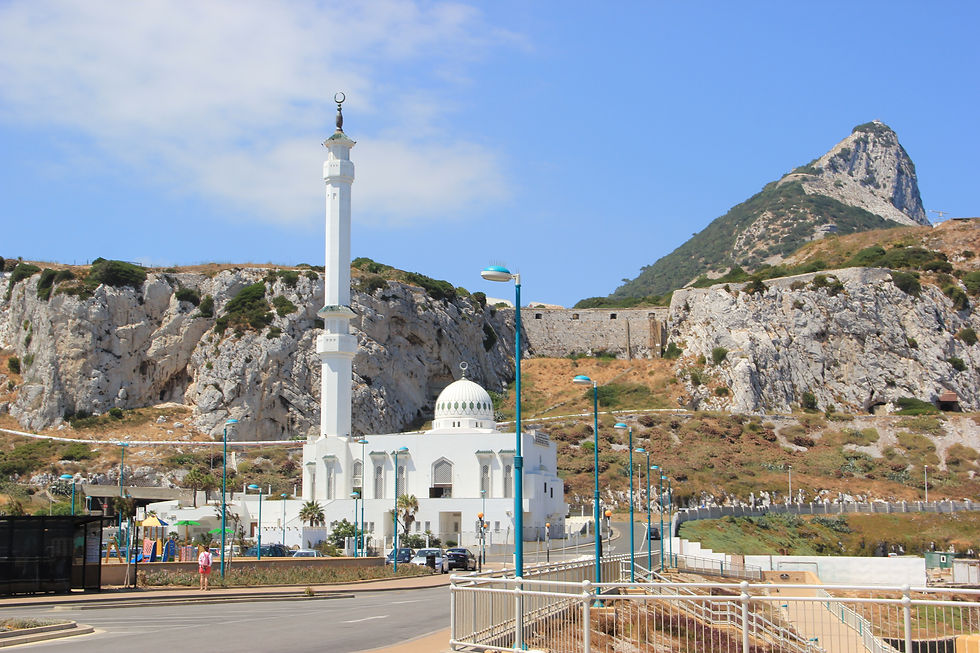
The Ibrahim-al-Ibrahim Mosque, also known as the King Fahd bin Abdulaziz al-Saud Mosque or the Mosque of the Custodian of the Two Holy Mosques, is a mosque located at Europa Point in the British overseas territory of Gibraltar, a peninsula connected to southern Spain. The mosque faces south towards the Strait of Gibraltar and the African country of Morocco several miles away.
The building was a gift from King Fahd of Saudi Arabia and took two years to build at a cost of around £5 million. It was officially inaugurated on 8 August 1997. When the building was opened there was over sixty limousines and impressive security measures. It is the southernmost mosque in continental Europe, and is one of the largest mosques in a non-Muslim country. The mosque complex also contains a school, library, and lecture hall. It is the only purpose-built mosque in Gibraltar to serve the Muslims in the territory who number over 1,000: around 4% of Gibraltar's total population.
Princess Anne's Battery
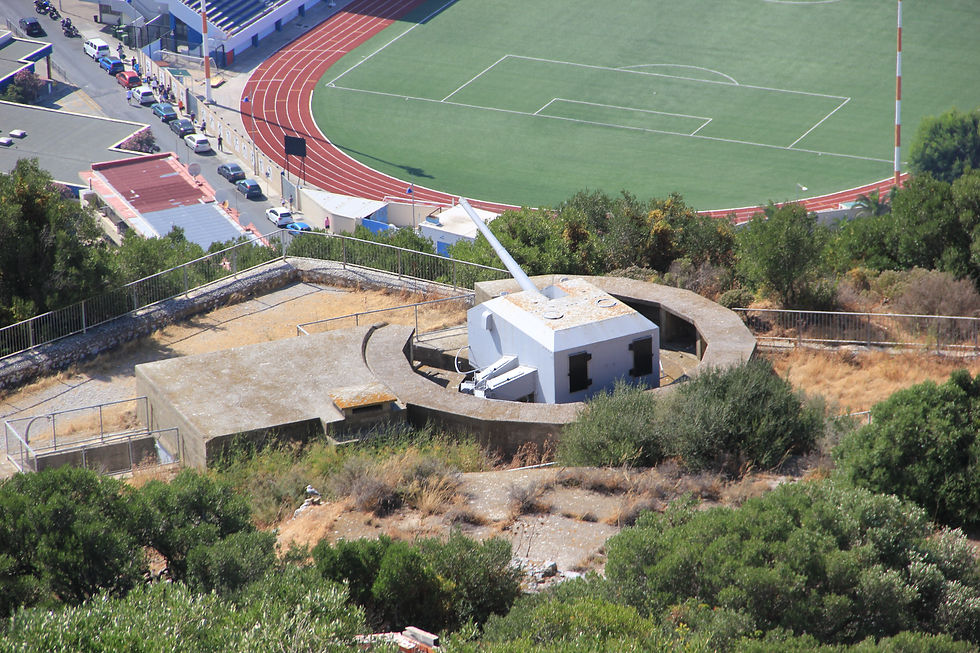
Princess Anne's Battery is an artillery battery in the British Overseas Territory of Gibraltar. It is located on Willis's Plateau at the northern end of the Upper Rock Nature Reserve, above Princess Caroline's Battery. It was named after Anne, Princess Royal and Princess of Orange, the eldest daughter of George II. However, its name is often confused with those of other batteries in the area. In 1732, guns were first mounted on the battery, which also saw action during the Great Siege of Gibraltar. Princess Anne's Battery was updated in the nineteenth and twentieth centuries, with the latter modernisation entailing the installation of four QF 5.25 inch guns with both anti-aircraft and coastal defence capabilities. The battery was manned into the early 1980s, after which it was decommissioned. The guns were refurbished in the early twenty-first century, and represent the world's only intact battery of 5.25 inch anti-aircraft guns. Princess Anne's Battery is listed with the Gibraltar Heritage Trust. Princess Anne's Battery is in Gibraltar, the British Overseas Territory at the southern end of the Iberian Peninsula. The artillery battery is located on Willis's Plateau at the northern end of the Upper Rock Nature Reserve, below the Great Siege Tunnels and above Princess Caroline's Battery. It overlooks Spain, Gibraltar International Airport, and theBay of Gibraltar. The site was initially known as the 3rd Willis's Battery. It was renamed after Anne, Princess Royal (1709 – 1759), the eldest daughter of King George II, also known as Princess Anne of Orange following her marriage to William IV, Prince of Orange. The battery's position off Willis's Road near Princess Caroline's Battery is thought to be responsible for it frequently being mistaken for that battery. It is also sometimes referred to as St. Anne's Battery, or confused with Princess Amelia's Battery or Princess Royal's Battery, with the first a misnomer and the latter two in close proximity to the Princess Anne's Battery site. The battery was built in 1732, with the guns mounted at that time consisting of five 12 pounders. In 1771, it was reported that Princess Anne's Battery had five cannons directed toward the isthmus, and another four to address "the rear of the enemy approaches." It was in use at the time of the Great Siege of Gibraltar, and an explosion of the magazine at Princess Anne's Battery on 11 June 1782 took the lives of fourteen men. The following August, the flank of the battery was rebuilt. Later, in the nineteenth century, the battery was updated with four 3 inch guns and three 13 inch mortars. During the mid twentieth century, Princess Anne's Battery was refurbished. While the decision was made in 1942 to arm it with new guns, it wasn't until 1956 that four new QF 5.25 inch guns serving a dual role had been installed on the battery. They performed both anti-aircraft and coastal defense functions and featured completely enclosed turrets, with a 1 B mounting. The four guns are partially surrounded by concrete rings which contain ammunition lockers. Three of the emplacements feature concrete bunkers with partially sunken magazines and engine rooms off to the side, while the fourth's magazine and engine room are completely subterranean. Gun No. 4 is on somewhat higher ground than the first three guns. It is also immediately adjacent to the site of Princess Amelia's Battery. Princess Anne's Battery was staffed and operational into the early 1980s. Since then, the guns have been decommissioned and have sustained the effects of weather and vandalism. Accordingly, security measures now prevent easy access to the site, which is not routinely open to the public. Rather, access is arranged through the Gibraltar Tourist Board. At the turn of the twenty-first century, it was proposed that the area be developed as a tourist attraction. While improvements were made to the area, ultimately opposition to the suggestion put the plans on hold. The guns have recently been refurbished. The restoration of gun No. 3 at Princess Anne's Battery was performed in two phases, in July 2006 and September 2007. The 2006 refurbishment was undertaken by members of the 106 (Yeomanry) Regiment of the Royal Artillery during exercise Marble Tor 5. The 2007 restoration was performed by the 101 Battalion of the Corps of Royal Electrical and Mechanical Engineers (Volunteers) during exercise Marble Tor 6. In 2008, retired Major David Seed received a special commendation during the presentation of Heritage Awards by the Gibraltar Heritage Trust. His award acknowledged the role he played in arranging the annual Marble Tor exercises that involved refurbishment of heritage sites, including not only Princess Anne's Battery, but also Flat Bastion Magazine,Parson's Lodge Battery, Witham's Cemetery, and the 100 ton gun. In May 2011, the Gibraltar Heritage Trust sponsored the 22nd annual painting contest. Princess Anne's Battery and Princess Caroline's Battery were the themes of the competition, whose winners were awarded prizes by the Governor of Gibraltar, Sir Adrian Johns. Princess Anne's Battery is listed with the Gibraltar Heritage Trust, and represents the world's only complete battery of 5.25 inch anti-aircraft guns
Gibraltar International Airport

Gibraltar International Airport or North Front Airport is the civilian airport that serves the British overseas territory of Gibraltar. The runway is owned by the Ministry of Defence for use by Royal Air Force as RAF Gibraltar. Civilian operators use the civilian-operated terminal. National Air Traffic Services hold the contract for provision of air navigation services at the airport.
In 2004 the airport handled 314,375 passengers and 380 tonnes of cargo. Winston Churchill Avenue (the main road heading towards the land border with Spain) intersects the airport runway, and consequently has to be closed every time a plane lands or departs. The History Channel programme Most Extreme Airports ranked the airport the fifth most extreme airport in the world. Monarch is the largest operator at Gibraltar International, operating three weekly flights to London Luton, Manchester Airport and Birmingham. Both routes are operated by an Airbus A320-200. EasyJet operates seven weekly flights to London Gatwick operated by Airbus A320 family aircraft. British Airways also operates nine weekly flights to London Heathrow being operated by an Airbus A320-200. Although located in Gibraltar, the airport is also used by people travelling to or from neighbouring parts of the southern Spain such as the Costa del Sol or the Campo de Gibraltar.

The airport was constructed during World War II upon the territory's race course (introduced by the Maltese), when Gibraltar was an important naval base for the British. Originally opened in 1939, it was only an emergency airfield for the Royal Navy's Fleet Air Arm. However, the runway was later extended by reclaiming some land from the Bay of Gibraltar using rock blasted from the Rock of Gibraltar while carrying out works on military tunnels. This last major extension of the runway allowed larger aircraft to land at Gibraltar. Spain's continuing sovereignty dispute with the United Kingdom over the territory where the airport stands (different from the generic one on Gibraltar itself) has seriously affected the airport's operations. On 2 December 1987, an agreement was signed between the governments of the United Kingdom and Spain to allow the joint civil use of the airport. The agreement foresaw the building of a new terminal in the neighbouring Spanish municipality of La Línea de la Concepción adjacent to the northern side of the existing frontier. However, the agreement was blocked by the Government of Gibraltar, led from 1988 by Joe Bossano. As a result, the agreement was never implemented. Since then, Spain successfully excluded Gibraltar from European wide de-regulation initiatives, preventing direct links from Gibraltar to the rest of the European Union (except the United Kingdom), on the grounds that no regulation that somehow recognises the sovereignty of the United Kingdom over the Gibraltar peninsula may be implemented without a previous agreement on the airport. On 3 November 2003, Monarch announced a new route from Gibraltar to Manchester Airport. It was the first route from Gibraltar to operate to the North of England. However on 19 July 2006, Monarch withdrew the route due to the cost. On 21 April 2008, Monarch announced it would resume the services to Manchester from 12 September 2008. The route operates three to five times a week: every Monday, Wednesday and Friday in winter season, as well as on Thursdays and Sundays in the summer season. By late 2005 and early 2006, the implementation of a new agreement was one of the main topics of the Gibraltar Trilateral Forum being held between the Governments of Gibraltar, Spain and the United Kingdom. As a result, the Córdoba Accord was signed on 18 September 2006 by all parties. This ended all discriminatory restrictions on civilian flights to Gibraltar International, including the prohibition of flights over Spanish soil, and exclusion of Gibraltar from all EU agreements on air transport, allowing civilian flights from all nations into Gibraltar International.
On 17 November 2006 Iberia announced that it would start flights from Madrid to Gibraltar using an Airbus A319 aircraft. This was a landmark move as no Spanish airline had flown to Gibraltar since 1979, because of its disputed status. Iberia began flights to Gibraltar International on 16 December 2006 with a flight from Madrid that included some members of theSpanish Government on board. GB Airways flew a one-off flight in the other direction with a group of children from the Gibraltar area making up the passengers. In May 2007 GB Airways (flying as a British Airways franchisee) also began operating the route between Madrid and Gibraltar, however, this was discontinued on 30 September, leaving Iberia to work the route alone. On 22 September 2008 Iberia announced that it would cease its flights to Madrid by 28 September due to "economic reasons", namely, lack of demand. This left Gibraltar, once again, without any air links with Spain. In April 2009 Ándalus Líneas Aéreas restored Gibraltar's air link with the Spanish capital. In July 2009 Ándalus also began scheduled flights to Barcelona, increasing the destinations in Spain to two.However, the airline ceased to serve this route in September 2009 due to a lack of demand. In April 2010 it was confirmed that Ándalus flights to and from Gibraltar had been indefinitely suspended. And now yet again, Gibraltar has no direct air links to Spain. Ándalus Líneas Aéreas ceased operations on 13 August 2010. From 2011 until October 2012, EasyJet offered thrice-weekly service from Gibraltar to Liverpool, but it was eventually cancelled due to lack of demand.

On 18 May 2011, Bmibaby announced that it would launch flights from Gibraltar to East Midlands from 31 March 2012. This was the first time that an airline has operated that route. The route operated on Tuesdays, Thursdays and Saturdays, using a Boeing 737-300. However on 3 May 2012 it was announced that Bmibaby was to be closed down by the International Airlines Group after the group failed to find a buyer for the airline. Bmibaby operated its last service to Gibraltar on 8 September 2012 and the airline operated its last flight on 9 September 2012. On 10 January 2012, Gibraltar was selected as one of the 'World's Scariest Airport Landings and Take-offs' in the travel section of the Daily Telegraph due to its runway which extends into the sea. On 14 August 2012, Monarch announced it would launch a new route to Birmingham, operating three times a week; every Tuesday, Thursday and Saturday. The route began on 23 March 2013 but now runs on Tuesdays, Thursdays and Sundays. It was announced in January 2014 that an air route between Gibraltar and Marrakech would be established and launched in April. The flight will be operated by Royal Air Maroc Express on behalf of Your Flight. The reservation agent for the flights will be MH Bland Travel Services.


Comments